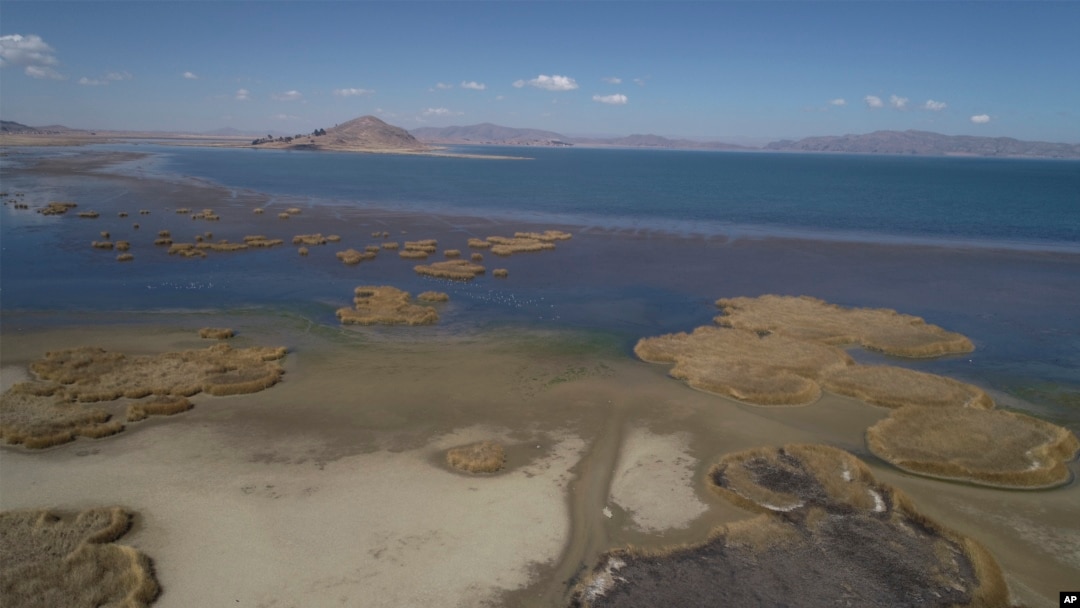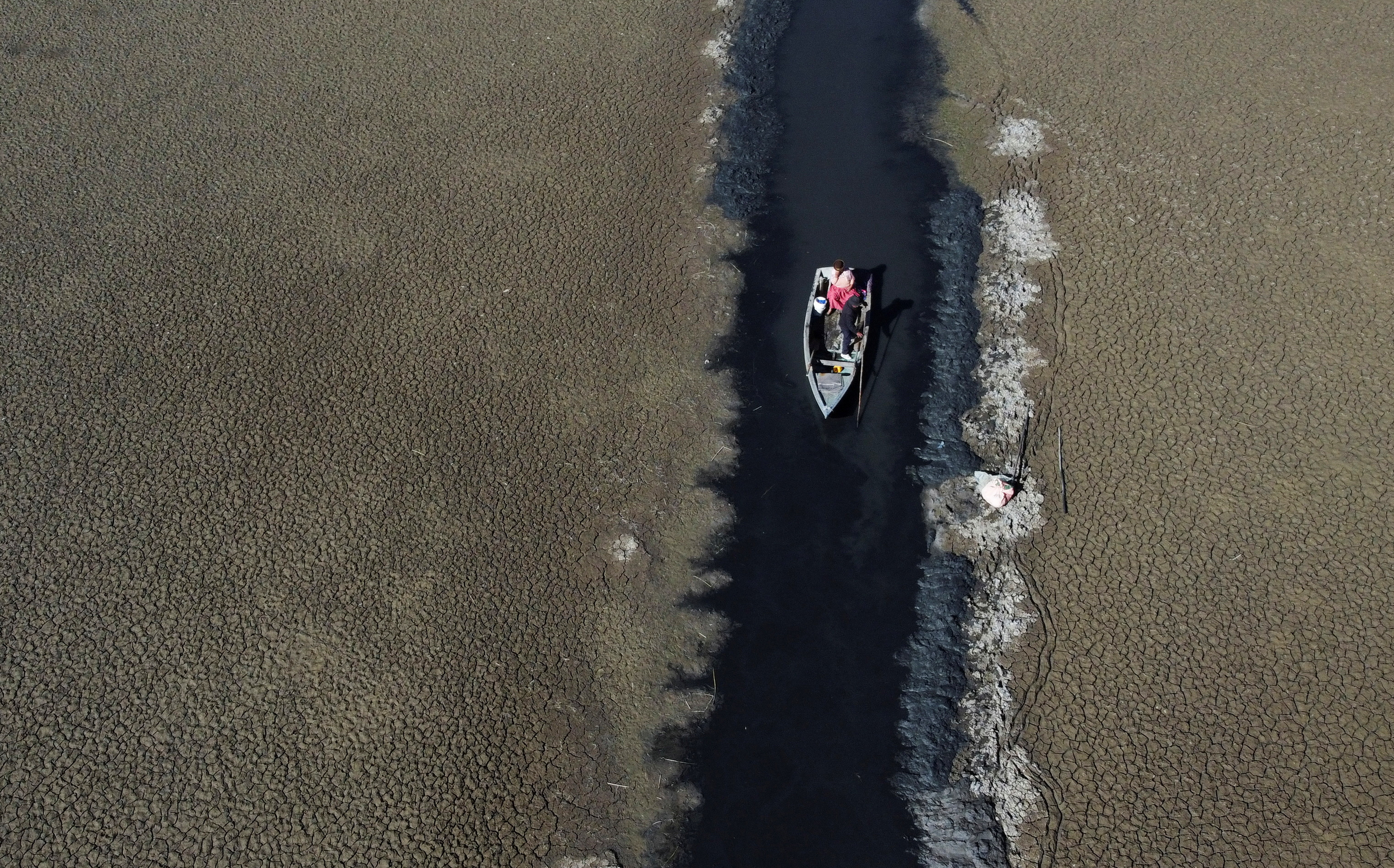Crisis Unfolds: Lake Titicaca, the World’s Highest Navigable Lake, Faces a Devastating Drought

Crisis Unfolds: Lake Titicaca, the World’s Highest Navigable Lake, Faces a Devastating Drought
Lake Titicaca, the crown jewel of South America‘s natural wonders and the highest navigable lake on the planet, is in the throes of an unprecedented crisis. This picturesque lake, spanning over 3,200 square miles on the border of Peru and Bolivia, is in the grip of a relentless drought, threatening the livelihoods of its indigenous communities and the region’s economy as a whole.
The dramatic decline in water levels is primarily attributed to an unprecedented winter heat wave that has rocked the central Andes mountain range, where Lake Titicaca is perched at a staggering altitude of around 3,800 meters (12,500 feet). This heat wave has triggered alarming evaporation rates, significantly depleting the lake’s water reserves, and leaving residents and stakeholders grappling with an uncertain future.
The consequences of this ecological catastrophe are already reverberating throughout the region. Tourism, fishing, and agriculture, vital pillars of the local economy, are under severe threat, pushing many to the brink of despair.

Uncharted Turbulence for Tourism
Lake Titicaca’s enchanting blue waters, framed by the open skies of the Andes, have been a magnet for tourists seeking nature’s beauty and cultural richness. However, the parched lake is dealing a crippling blow to the tourism industry, which has been a lifeline for many residents.
Tour operators like Nazario Charca, a 63-year-old who has made his living ferrying tourists across the lake, are now left grappling with an uncertain future. He laments, “We don’t know what we will do from now until December because the water will keep getting lower.” As water levels continue to plummet, boat tours that once attracted travelers from around the world are now navigating the murky waters of an uncertain future.
Fishermen’s Fears and Vanishing Livelihoods
The dwindling water levels have thrown a shadow of uncertainty over the region’s fishing industry. For generations, the pristine waters of Lake Titicaca have been a vital source of sustenance for countless families. Fishermen, who have depended on the lake’s bounty, are now struggling to cast their nets into the shrinking expanse of water.
Javier Mamani, a local fisherman, shared his concerns, “The lake used to be so much larger, and we could catch fish easily. Now, it’s getting harder every day.” The declining fish populations and the logistical challenges posed by the shrinking shoreline are pushing fishermen to their limits. With livelihoods at stake, they are left grappling with the harsh reality of an ecosystem in peril.

Agriculture’s Alarming Albatross
Agriculture, too, is feeling the brunt of Lake Titicaca’s devastating drought. The lake’s waters have been a crucial resource for irrigation, ensuring bountiful harvests in this harsh, high-altitude environment. However, with water levels plummeting, farmers are faced with parched fields and uncertain yields.
Luisa Quispe, a local farmer, voiced her concerns, “Our crops are drying up, and we are struggling to grow enough food. This threatens our food security and our way of life.” The dependence on lake water for agriculture has been a cornerstone of the region’s sustainability, and its abrupt depletion poses a significant challenge for the communities that call this rugged terrain home.
Indigenous Communities in Peril
Lake Titicaca is not just a body of water; it’s a cultural and ecological treasure trove. Home to Aymara, Quechua, and Uros indigenous communities, the lake represents a sacred space that has sustained these cultures for centuries. However, the ongoing crisis is putting immense strain on the way of life for these communities.
Elena Quispe, an Aymara elder, expressed her anguish, “Our ancestors have lived here for generations, and now we are witnessing the lake we hold sacred diminish before our eyes. It’s a heartbreaking sight.” The erosion of the lake’s water levels not only threatens the livelihoods of these indigenous groups but also their cultural heritage, which is deeply intertwined with the lake’s waters.
The Rising Toll of Climate Change
The drying of Lake Titicaca is not an isolated incident but a grim reminder of the global repercussions of climate change. Rising temperatures and altered weather patterns are increasingly impacting fragile ecosystems worldwide. The lake’s extreme altitude, which exposes it to high levels of solar radiation, exacerbates the problem, accelerating evaporation and contributing to its water losses.
Scientists warn that without immediate and sustained efforts to address climate change, we may witness similar crises unfolding in other regions, with devastating consequences for both the environment and human societies.
A Call for Action
As Lake Titicaca continues to shrink, it is clear that urgent action is needed to mitigate the crisis and support the affected communities. The international community, governments of Peru and Bolivia, and local stakeholders must come together to address this multifaceted challenge.
1. Preserving Indigenous Heritage: Efforts should be made to safeguard the cultural heritage of the Aymara, Quechua, and Uros communities who call Lake Titicaca home. Initiatives should focus on preserving traditional knowledge and practices that have sustained these cultures for generations.
2. Sustainable Tourism: Tourism can play a crucial role in the region’s recovery. Sustainable tourism practices should be encouraged, ensuring that the economic benefits of tourism are shared equitably among local communities and do not further harm the environment.
3. Conservation and Restoration: Robust conservation efforts are required to protect the lake’s fragile ecosystem. Restoration projects should be initiated to replenish the lake’s water levels and enhance its resilience to future climate shocks.
4. Climate Mitigation: Climate change mitigation measures are essential to prevent similar crises from occurring elsewhere. Reducing greenhouse gas emissions and transitioning to sustainable energy sources are key steps in this direction.
5. Community Support: Providing economic and social support to affected communities is imperative. Initiatives should focus on diversifying livelihoods and ensuring food security to mitigate the immediate impact of the crisis.
In the face of this unprecedented challenge, the world must unite to protect Lake Titicaca and its surrounding communities. The fate of this remarkable natural wonder hangs in the balance, and the time to act is now. By taking swift and decisive action, we can hope to restore this unique ecosystem and secure a better future for all those who depend on it. Lake Titicaca’s resilience will ultimately depend on our collective commitment to preserving one of nature’s most extraordinary gifts.




